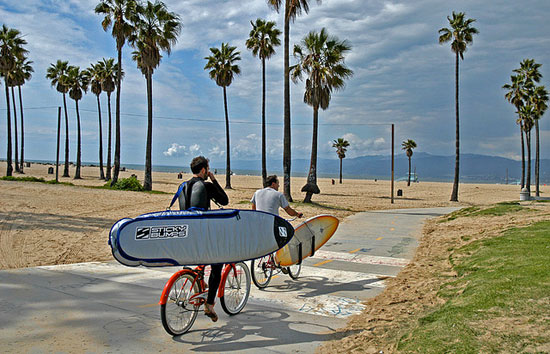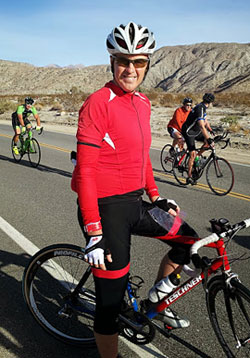
County officials will soon launch an adopt-a-bike path program, complete with recognition signs.
Attorney Steve Hansen makes no apologies for getting under the skin of government bureaucrats. “If I annoy people,” he says, “it’s for good reason. I only nag about stuff that’s justifiable.”
Most of his nagging has centered on the county’s bike paths, particularly the San Gabriel River Bikeway, which begins in Azusa and ends in Seal Beach. An avid, high-mileage cyclist, Hansen’s been riding it for nearly three decades. His dad, at age 78, still gets out there on his bike four times a week.
For years, Hansen has been firing off emails complaining about everything from the bikeway’s underpass dangers to its undulating asphalt to potential crime problems along the 28-mile route. Many of those bluntly-worded missives have filled the in-box of Allan Abramson, a senior civil engineer in the L.A. County Department of Public Works, who, among other things, oversees bikeways.
He calls Hansen, who heads a community advocacy group in Lakewood, “a gadfly.”
“On certain things, he’s very reasonable,” Abramson says. “In some things, there’s a certain semblance of unreasonableness.”
But late last year, Abramson says, the gadfly hit on an idea that made sense. “A winner,” Abramson calls it. (“A no-brainer,” in Hansen’s words.) He suggested that the county start an adopt-a-bike path program along the San Gabriel River Bikeway, modeled after popular state highway programs, complete with signs recognizing those who’ve adopted a stretch to keep clean.

Steve Hansen, the cyclist behind the new plan.
Hansen says a bike club with which he was riding “thought it would be cool to have their name on the path. It was an advertising thing, for a good cause.” Public works officials liked the idea so much that they decided to expand it to dedicated bikeways throughout the county. They’ll be promoting the program, scheduled to be launched in the weeks ahead, as a way for organizations and individuals to support health, recreation and “active transportation” in their local communities.
Abramson acknowledges that the program probably wouldn’t have happened without Hansen’s agitation. “I’m comfortable giving him credit,” Abramson says.
Under draft requirements of the adopt-a-bike path program, organizations, businesses and individuals who want to participate must commit to collecting litter, sweeping and trimming vegetation along the path at least four times a year for a minimum of two years. There’ll be no costs to the adoptees. Vests, hardhats and trash bags will be supplied by the county, along with the program’s biggest draw: recognition signs that would be placed at each end of an adopted stretch.
Throughout the county, numerous segments of the 100 miles of bike paths maintained by the county will be up grabs—from the foothills to the sea.
Abramson says some details of the program remain to be worked out, including the county’s potential right-of-refusal when it comes to certain groups or individuals who might apply. “You don’t want to say on a sign that ‘the American Neo Nazis adopted this,’” Abramson explains.
He says the county also opted not to make painting over graffiti part of the program. “If gang members saw people spraying over their gang insignias, they could be in peril,” Abramson says.
As for Hansen, who’s been on cycling adventures throughout the world, he says he’ll continue riding the region’s public officials to make sure they keep making improvements on his home turf.
“I’ve been riding that path since 1986,” Hansen says, “and I know where all the problems are.”
Posted 3/19/14






